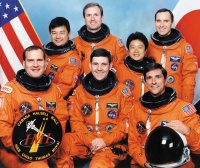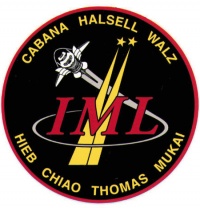STS-65
From The Space Library
 | |
| Organization | NASA-Office of Space Flight (United States) |
|---|---|
| Mission type | Human Crew |
| Launch date | July 8, 1994 |
| Launch vehicle | Space Shuttle |
| Launch site | Cape Canaveral, United States |
| COSPAR ID | 1994-039A |
| Inclination | 28.45 degrees |
| Experiments | Here |
| Alternate Names | 23173 |
| Additional Information | Here |
| Data Collection | Here |
| Payload Mass Up | 10811 kg |
| Payload Mass Down | 10834.55 kg |
| Orbiter | Columbia |
| Lift Off Mass | 2,055,670.45 kg |
| Orbiter Weight at Liftoff | 117,424.09 kg |
| Orbiter Weight at Landing | 104,328.18 kg |
| Landed | Concrete runway 33 at Kennedy Space Center, Fla. |
| Orbits of Earth | 236 |
| Orbital Altitude | 160 nautical miles (184 statute miles) |
Contents |
[edit] Crew
- Commander: Robert D. Cabana
- Pilot: James D. Halsell Jr.
- Payload Commander: Richard J. Hieb
- Mission Specialist 1: Carl E. Walz
- Mission Specialist 2: Leroy Chiao
- Mission Specialist 3: Donald A. Thomas
- Mission Specialist 4:
- Mission Specialist 5:
- Payload Specialist 1: Chiaki Mukai, Japan
- Payload Specialist 2:
ISS/Mir Crew Transport
[edit] Mission
STS 65 was launched from Cape Canaveral. It carried the International Microgravity Laboratory (IML-2), the second in a series of Spacelab (SL) flights designed to conduct research in a microgravity environment. The IML concept enables a scientist to apply results from one mission to the next and to broaden the scope and variety of investigations between missions. Data from the IML missions contributes to the research base for the space station. As the name implies, IML-2 is an international mission. Scientists from the European Space Agency (ESA), Canada, France, Germany and Japan are all collaborating with NASA on the IML-2 mission to provide the worldwide science community with a variety of complementary facilities and experiments. These facilities and experiments are mounted in twenty 19" racks in the IML 2 Module. Research on IML-2 is dedicated to microgravity and life sciences. Microgravity science covers a broad range of activities from undestanding the fundamental physics involved in material behavior to using those effects to generate materials that cannot otherwise be made in the gravitational environment of the Earth. In life sciences research, a reduction of gravitation's effect allows certain characteristics of cells and organisms to be studied in isolation. These reduced gravitational effects also pose poorly understood occupational health problems for space crews ranging from space adaptation syndrome to long-term hormonal changes. On IML-2, the microgravity science and life sciences experiments arecomplementary in their use of SL resources. Microgravity science tends to draw heavily on spacecraft power while life sciences places the greatest demand on crew time. Life Sciences Experiments and facilities on IML-2 include: Aquatic Animal Experiment Unit (AAEU) in Rack 3, Biorack (BR) in Rack 5, Biostack (BSK) in Rack 9, Extended Duration Orbiter Medical Program (EDOMP) and Spinal Changes in Microgravity (SCM) in the Center Isle, Lower Body Negative Pressure Device (LBNPD), Microbial Air Sampler (MAS), Performance Assessment Workstation (PAWS) in the middeck, Slow Rotating Centrifuge Microscope (NIZEMI) in Rack 7, Real Time Radiation Monitoring Device (RRMD) and the Thermoelectric Incubator (TEI) both in Rack 3. Microgravity experiments and facilities on IML-2 include: Applied Research on Separation Methods (RAMSES) in Rack 6, Bubble, Drop and Particle Unit (BDPU) in Rack 8, Critical Point Facility (CPF) in Rack 9, Electromagnetic Containerless Processing Facility (TEMPUS) in Rack 10, Free Flow Electrophoresis Unit (FFEU)in Rack 3, Large Isothermal Furnace (LIF) in Rack 7, Quasi Steady Acceleration Measurement (QSAM) in Rack 3, Space Acceleration Measurement System (SAMS) in the Center Isle, and Vibration Isolation Box Experiment System (VIBES) in Rack 3. Other payloads on this mission are: Advanced Protein Crystalization Facility (APCF) , Commercial Protein Crystal Growth (CPCG), Air Force Maui Optical Site (AMOS) Calibration Test, Orbital Acceleration Research Experiment (OARE), Military Application of Ship Tracks (MAST), Shuttle Amateur Radio Experiment-II (SAREX-II). Columbia is also flying with an Extended Duration Orbiter (ED0) pallet and no RMS Arm was installed. This is also the 1st flight of the payload bay door torque box modification on Columbia and the 1st flight of new OI-6 main engine software.
[edit] EVA
[edit] Payload
International Microgravity Laboratory (IML) 2; Orbital Acceleration Research Experiment (OARE); Commercial Protein Crystal Growth (CPCG); Air Force Maui Optical Site (AMOS); Military Applications of Ship Tracks (MAST); Shuttle Amateur Radio Experiment (SAREX)
[edit] Books about the Space Shuttle Program
Buy This Book Click here |
Buy This Book here |
Buy This Book Click here |
Buy This Book Click here |





